23-02-2024 - Physics - Radiative heat exchange between flat surfaces [EN]-[IT]
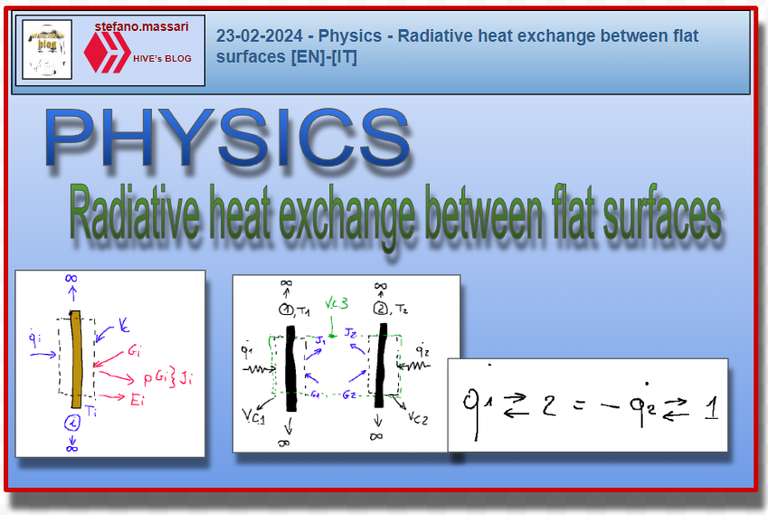
~~~ La versione in italiano inizia subito dopo la versione in inglese ~~~
ENGLISH
23-02-2024 - Physics - Radiative heat exchange between flat surfaces [EN]-[IT]
Radiative heat exchange between flat surfaces
Heat transmission, or even thermal exchange, is the transport phenomenon that moves thermal energy between two thermodynamic systems. This occurs because of a temperature difference and because the two systems will seek thermal equilibrium. Let us remember that the second law of thermodynamics tells us that during the search for equilibrium heat passes from hot to cold heat.
The heat exchange between parallel and undefined flat surfaces is analyzed below.
Let's take as an example any surface at temperature Ti then choose a control volume (v.c.) so that the surface is contained in it.
Below is a drawing to better clarify what is described above.
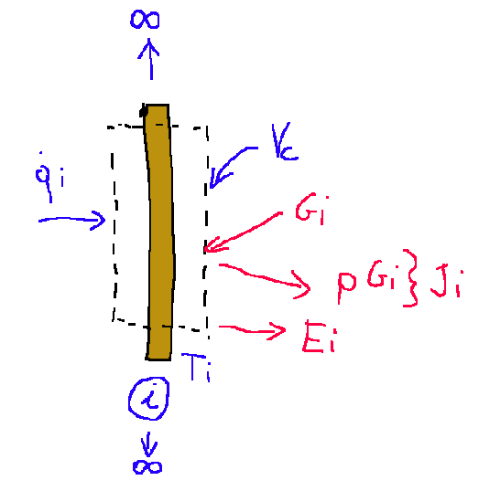
At the beginning we remembered the second law of thermodynamics, now let's remember the first by looking at the drawing.
The first law of thermodynamics allows us to deduce that the thermal energy, supplied by an external source so that the surface remains at the temperature Ti, is equal to the difference between the output (Ji) and input (Gi) thermal energies.
We can therefore write the following formula
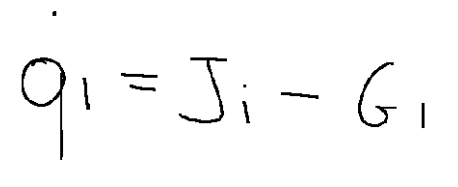
Let us now think about the case of two parallel flat surfaces called 1 and 2 at temperatures T1 and T2. The drawing below helps to better understand the situation.
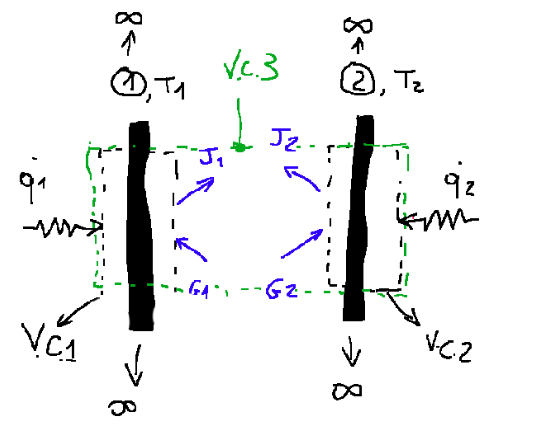
Now we can do the energy balance by thinking about what was written in the first case
For v.c.1 the energy balance is q1 = J1 - G1
For v.c.2 the energy balance is q2 = J2 - G2
For v.c.3 the energy balance is q1 = - q2
Analyzing this situation we can notice that what arrives on one wall is exactly the same as what came from the other. So in this system J1=G2 and J2=G1
Considering the two surfaces as black, no incident energy will be reflected, which is why ρi Gi = 0. Consequently, radiosity and emissive power coincide, Ji = Ei.
We can therefore describe q1 as follows.

If the two surfaces were gray q1 will be a more complex formula and will become as follows:
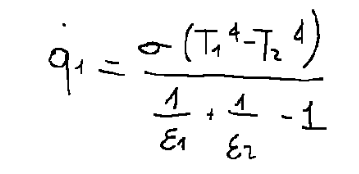
If one surface were gray and the other black we would instead have that surface 2 would have the following formula:

CONCLUSIONS
From the study of the radiative heat exchange between parallel flat surfaces, we can rewrite the following formula

In the following manner

Where:
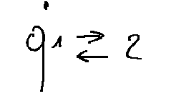
is the net thermal power, per unit area, exchanged between surfaces 1 and 2

is the net thermal power, per unit area, exchanged between surfaces 2 and 1
Request
These may be quite complex studies, but do you agree with me that they are and will be very useful in the field of building construction aimed at energy saving?

23-02-2024 - Fisica - Scambio termico radiativo tra superfici piane [EN]-[IT]
Scambio termico radiativo tra superfici piane
La trasmissione del calore, o anche scambio termico, è il fenomeno di trasporto che muove l'energia termica tra due sistemi termodinamici. Questo avviene a causa di una differenza di temperatura e perché i due sistemi cercheranno un equilibrio termico. Ricordiamo che il secondo principio della termodinamica ci dice che durante la fase di ricerca dell’equilibrio il calore passa da quello caldo a quello freddo.
Qui di seguito si analizza lo scambio termico tra superfici piane parallele e indefinite.
Prendiamo come esempio una superficie qualsiasi alla temperatura Ti poi scegliamo un volume di controllo (v.c.) in maniera che in esso è contenuta la superficie.
Qui di seguito un disegno per chiarire meglio ciò che è descritto sopra.

All’inizio abbiamo ricordato il secondo principio della termodinamica, ora ricordiamo il primo guardando il disegno.
Il primo principio della termodinamica consente di dedurre che l’energia termica, fornita da una sorgente esterna affinché la superficie rimanga alla temperatura Ti, è pari alla differenza tra le energie termiche in uscita (Ji) e in ingresso (Gi).
Possiamo quindi scrivere la formula seguente

Pensiamo adesso al caso di due superfici piane parallele chiamate 1 e 2 alle temperature T1 e T2. Il disegno qui sotto riportato serve a comprendere meglio la situazione.

Ora possiamo fare il bilancio di energia pensando a quello che è stato scritto nel primo caso
Per v.c.1 il bilancio di energia è q1 = J1 - G1
Per v.c.2 il bilancio di energia è q2 = J2 - G2
Per v.c.3 il bilancio di energia è q1 = - q2
Analizzando questa situazione possiamo notare che ciò che arriva su una parete è esattamente uguale a quella che è partita dall’altra. Quindi in questo sistema J1=G2 e J2=G1
Considerando le due superficie come nere non verrà riflessa nessuna energia incidente per ciò avremo che ρi Gi = 0. Di conseguenza radiosità e potere emissivo coincidono, Ji = Ei.
Possiamo descrivere quindi q1 come segue.

Se le due superfici fossero grigie q1 sarà una formula più complessa e diventerà come segue:

Se una superficie fosse grigia e l’altra nera avremo invece che la superficie 2 avrà la seguente formula:

CONCLUSIONI
Dallo studio dello scambio termico radiativo tra superfici piane parallele, possiamo riscrivere la seguente formula

Nella seguente maniera

Dove:

è la potenza termica netta, per unità di area, scambiata tra le superfici 1 e 2

è la potenza termica netta, per unità di area, scambiata tra le superfici 2 e 1
Domanda
Questi possono essere studi abbastanza complessi, ma siete d'accordo con me che sono e saranno molto utili nell'ambito delle costruzioni edili volte al risparmio energetico?
THE END
I really think I have studied this topic before. Quite interesting and informative
First of all, thanks for following me. The most interesting thing about this topic is that in the radiative heat exchange between flat, parallel and indefinite surfaces, one of which is black, we have the following relationship
Where:
q1-2=The net thermal power, per unit area, exchanged between surfaces 1 and 2
q2-1=The net thermal power, per unit area, exchanged between surfaces 2 and 1
@tipu curate
Upvoted 👌 (Mana: 2/42) Liquid rewards.
Grazie liberty per il tipu. Per ringraziarti ti lascio qui di seguito la relazione dello scambio termico radiativo fra superfici piane, parallele ed indefinite di cui una è un corpo nero
Non dovrei parlare di chimica in questo post di fisica, ma il tuo supporto per me è ossigeno.
Is there another short formula we can use to actually calculate this
Thanks for stopping by. In the radiative heat exchange between flat, parallel and indefinite surfaces, one of which is black, we arrive at the following conclusion.